Sweeping Down the Main
Published May 2025
By David Joshua Jennings | 17 min read
There’s a certain silence only sailors know. It comes when the sails are hoisted and trimmed precisely, a smooth headwind pulls you through its secret groove, and there is only the damp slap of waves on the hull. Here, the stench of gasoline doesn’t smother the subtle aroma of the water; no engine machine-guns the ears. Instead, you hear the wind, the birds. You notice the presence of wind on the water, how it is always changing. You’re closer to nature. And you feel a unique pride—the satisfaction of knowing how to move a boat full of passengers through the world simply by aligning yourself with the wind using only knowledge and ropes. It sounds nice, but for many, such a serene scene feels unreachable. This is because sailing, for various reasons, often is seen as a pastime of the wealthy. It is thought that only they have the excess time and income to enjoy such a pursuit. The truth, however, is that many of those who sail do so with very little money.
I began learning to sail in 2021 as a way to have adventures while global pandemic restrictions made travel difficult. I studied free materials online, refined my knowledge with the vast archive of free instructional videos on YouTube, then learned for free by showing up to yacht clubs on race nights and volunteering to help in any way I could. By showing up consistently and paying close attention, I became useful. Since then, I have sailed in many states, around the Gulf of Mexico, the Sea of Cortez, the Pacific, the Mediterranean, and the west coast of Africa. In late 2022, I crossed the Atlantic from Europe to the Caribbean. In a few short years, I amassed thousands of miles of experience. How much did this education, and all these sailing adventures, cost me? Almost nothing-—except my time. Sailing, as I said, is not only for the wealthy.
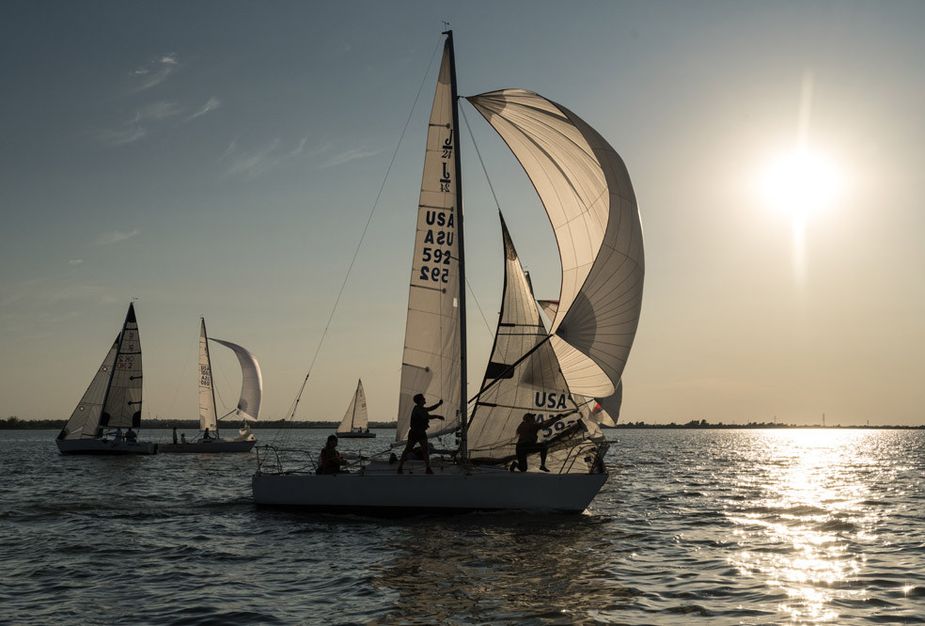
The Oklahoma City Boat Club, which organizes most sailing events at Lake Hefner, was incorporated in 1944. Photo by David Joshua Jennings
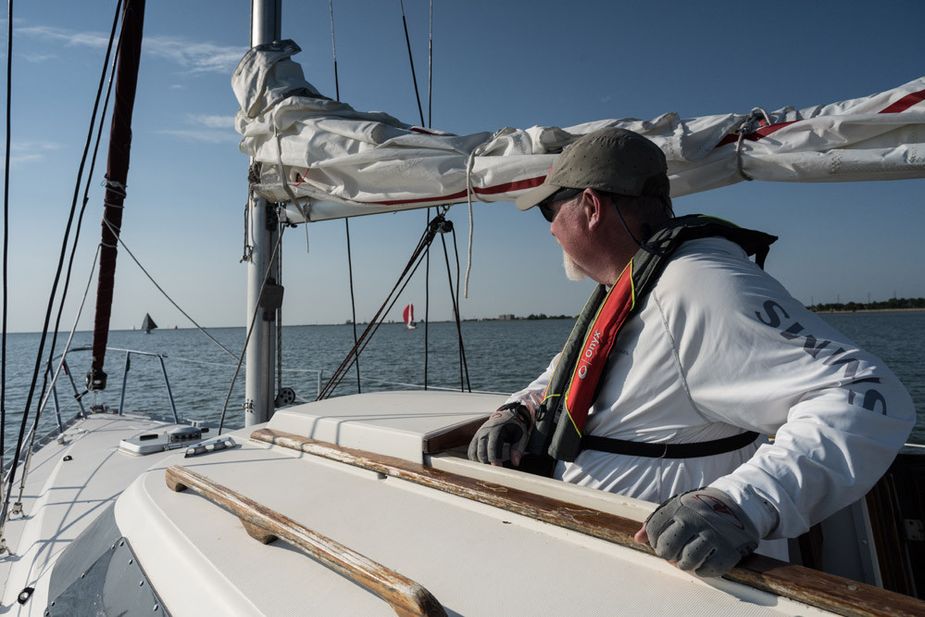
Rodney Brown has been sailing at Lake Hefner since the mid-1990s. Photo by David Joshua Jennings
This brings us to Oklahoma, a landlocked state near the geographic center of the country with no natural lakes besides the occasional tiny oxbow or playa. But Oklahoma does have tens of thousands of miles of shoreline on more than two hundred manmade lakes with around 1,300 square miles of water area. It also has a direct route from the Tulsa Port of Catoosa—one of the furthest inland ice-free ports in the United States—to the Mississippi River and ultimately to the Gulf of Mexico and beyond. That’s right: You can reach Madagascar, Tahiti, or Russia from Oklahoma by boat.
Oklahoma also has an abundance of the most essential element in the world of sailing: wind. Oklahoma is one of the windiest states in the nation, with an average wind speed of around seventeen miles per hour, which is a nice sporty breeze for sailing. Its position—where cold, dry air from Canada meets the warm, moist air from the Gulf—in addition to its relative dearth of forests and mountain ranges, contributes to this consistent supply of sailboat fuel.
For those accustomed to skipping across lakes on powerboats, sailing is an entirely different way of being. It can be meditative—that, typically, is the primary appeal—but it also can be an adrenaline rush. For those who’ve had the opportunity to enjoy Oklahoma’s rich natural beauty aboard a powerboat, imagine going deeper into that beauty within the rich silence of a sailing vessel. Meanwhile, for sporting types, many lakes host weekly races and occasional regattas so sailors can refine and test their skills against others.
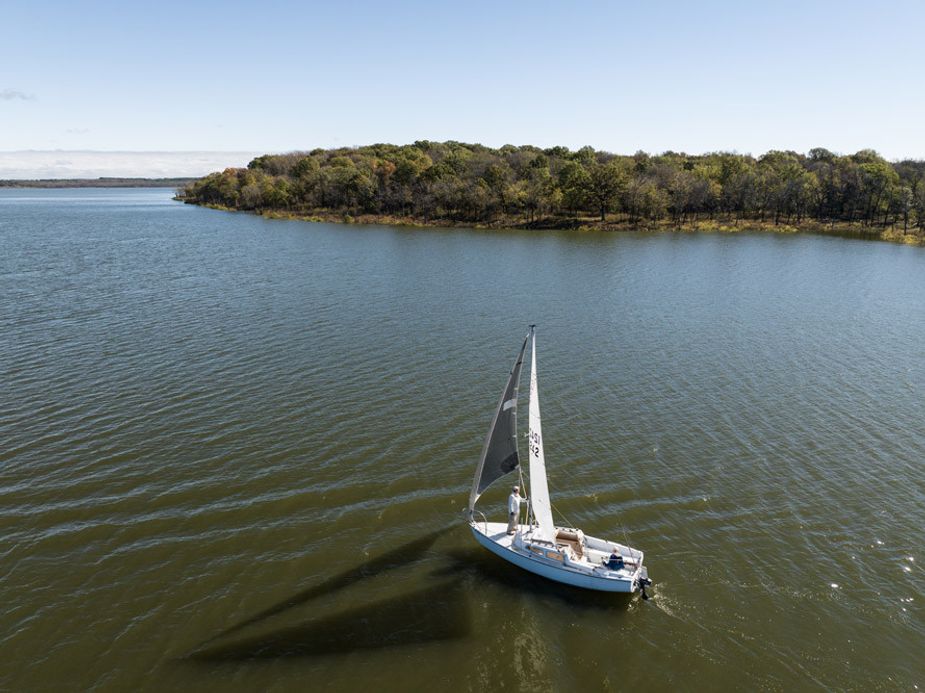
The Tsa-La-Gi Yacht Club at Fort Gibson Lake is home to one of Oklahoma’s two American Sailing Association-certified sailing schools. Photo by David Joshua Jennings
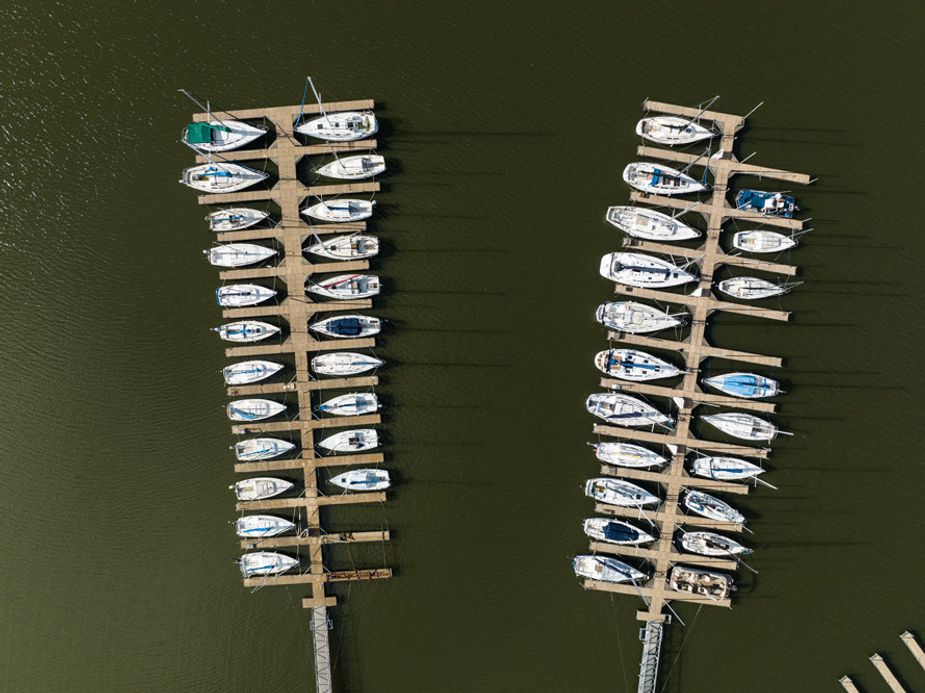
The Tsa-La-Gi Yacht Club offers storage and dockage for members at Fort Gibson Lake. Photo by David Joshua Jennings
So Oklahoma has the water and the wind—now, how do you get started?
For a total beginner who wants to learn to sail with little or no money, the key is to leverage free resources and find opportunities for hands-on experience. Start by immersing yourself in sailing knowledge through books, free online courses, and YouTube tutorials. Websites like NauticEd and the American Sailing Association offer free basic sailing courses that cover fundamental concepts. Facebook sailing groups—there are many in Oklahoma—are a great way to connect with experienced sailors in your area who might be willing to share advice and tips or even take you along for your first sail.
Is your interest piqued? You might wonder how long it takes to learn to sail. There is no straightforward answer. It depends. You can learn the basics quickly, then spend the rest of your life refining this knowledge. If you are consistent in your practice and try to sail every week during the season, you will likely be a knowledgeable crew member within a few weeks or months. If you go out more often—or better yet, go out on your own—in full control of your own vessel, you will learn much quicker.
One of the first big hurdles is the terminology. If you step aboard a boat full of experienced sailors, it will seem like they are speaking another language—and they are. It is a language from antiquity, already ancient when most of our ancestors crossed oceans under sail to reach this continent. If you haven’t spent much time on the water, this language will be wholly unfamiliar. That’s why I used note cards to master the terminology when I first began learning. Once you know the correct names of things, your knowledge will deepen quickly. Another foundational thing to learn is a couple of useful sailing knots. Nearly everything on a boat is controlled by ropes, and knowing the best knots to use for various scenarios is essential. The knots must be strong—but also easy to untie.
Armed with the correct vocabulary and a couple of useful knots, the next step is to get practical experience on the water. Look for community sailing programs or clubs in your area that offer free or low-cost introductory sessions. Many yacht clubs and marinas host open houses or trial days where newbies can get a taste of sailing. Volunteer to crew on other people’s boats during casual races or day sails. This is an excellent way to learn for free while helping out, and it’s exactly how I got my start. I was told to show up at the marina on a race night with a six pack of beer and ask everyone I saw if I could sail with them. I was never turned down. Most people will be happy to have you along if they have space. Be proactive, show enthusiasm, and be willing to help with tasks like cleaning or maintenance in exchange for sailing instruction.
For those who prefer a more structured route, there are several marinas and clubs in Oklahoma that offer introductory and advanced classes for both children and adults, including the OKC Sailing School on Lake Hefner, All About Sailing School on Fort Gibson Lake in Wagoner, Redbud Marina on Oologah Lake, the Windycrest Sailing Club on Keystone Lake, the Grand Lake Sailing Club, and the Thunderbird Sailing Club on Lake Thunderbird.
Whichever path you choose, the key to learning is practice. Paying for the practice will probably get you there more quickly, but there are also many options for those looking to save.
Either way, the more you practice, the more valuable you will be as a crew member, and the more people will want to have you along on their boat. Year round, all over the world, captains are in search of useful crew to help sail their vessels on all sorts of adventures. Soon, you will be able to join them. And it can all begin here in the landlocked state of Oklahoma, with its beautiful windswept lakes, so surprisingly full of sailors, hundreds of miles from any open sea.
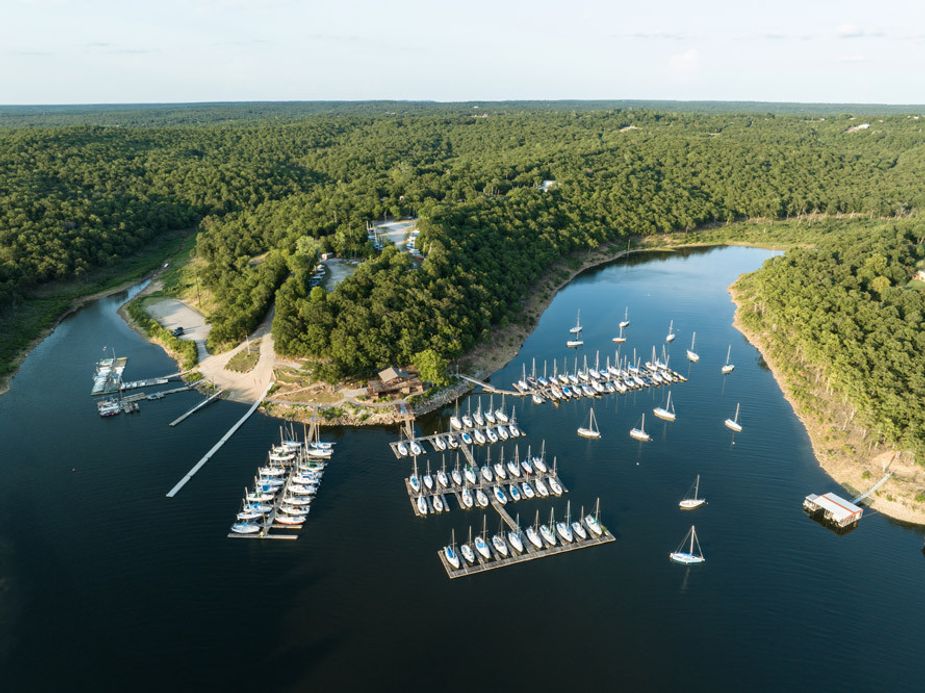
Keystone Lake near Tulsa is a popular destination for sailing enthusiasts. Photo by David Joshua Jennings
Talk Like a Sailor
Before you set sail, make sure you speak the language of the sea.
Bow/Stern: The bow is the forward part of the boat, and the stern is the rear. A good way to remember is that you bow forward, and steering is done from the stern—stern comes from the old Norse word stjórn, which means steering.
Port/Starboard: Port refers to the left side of the boat when facing forward, and starboard is the right. I remember starboard is right because it’s a word with two R sounds—R for right—while port has four letters, just like left.
Mainsail: Usually just referred to as the main, the mainsail is the boat’s primary and largest sail. The main’s luff—leading edge—is attached to the mast, while its foot—bottom edge—is attached to the boom.
Jib: The jib is a triangular sail set ahead of the mast. It is the most common type of headsail.
Gybe (or Jibe): Gybing is a sailing maneuver to change direction where the stern of the boat passes through the wind.
Boom: The boom is a heavy spar at the foot of a sail, usually just the mainsail. It is probably the most dangerous thing on a boat, as it can swing back and forth with great force, especially during gybes.
Tack: Tacking is a sailing maneuver to change direction by turning the bow through the wind. It also can refer to which side of the boat the sails are set and the wind is coming from. For example, if the sails are on the starboard side with the wind coming from the port side, you are on port tack, and vice versa. Tack also refers to the forward lower corner of any sail.
Helm: The helm is the steering mechanism of a boat, which can be either a tiller—steering pole—or a wheel. The helmsman is whoever is at the helm, helming.
Halyard: A halyard is a line used to raise and lower sails. On sailboats, ropes are called lines, and every line has a name according to its intended purpose.
Sheet: Sheets are lines used to control and trim—or adjust the shape of—the sails.
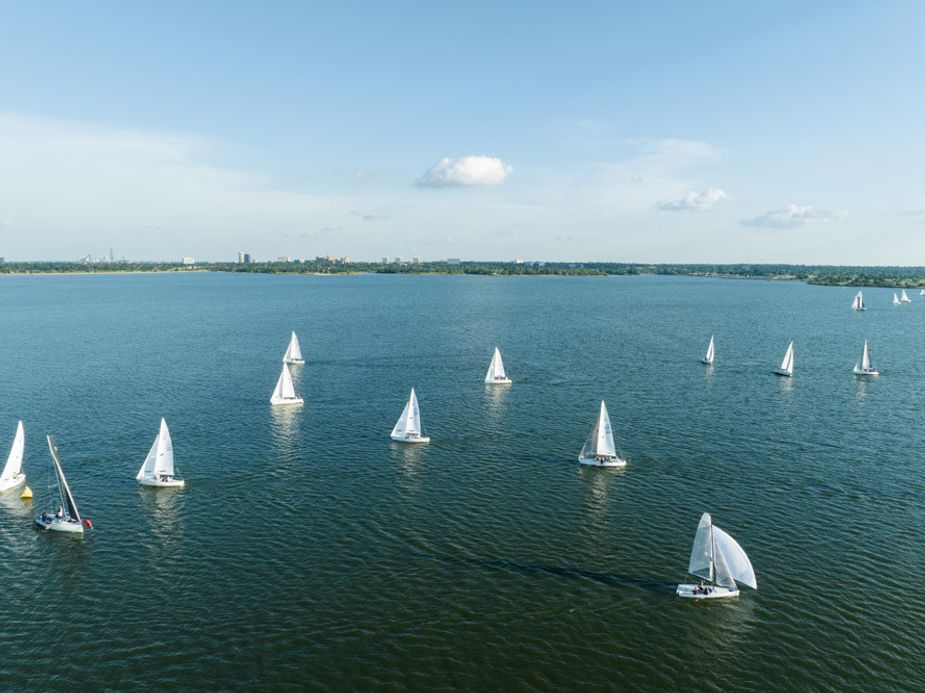
Sailing season at Lake Hefner in Oklahoma City typically runs April through October. Photo by David Joshua Jennings
Sail Away, Sail Away
Oologah Lake
Redbud Marina is the oldest American Sailing Association school in Oklahoma—one of only two in the state. They offer beginner and intermediate keelboat sailing courses as well as a course on Bareboat Cruising and Coastal Navigation. Redbud Marina also is one of the only places in Oklahoma you can rent a sailboat. The Spindrift Sailing Club, meanwhile, offers training to all members.
› 9001 East State Highway 88 in Claremore
› (918) 341-5190
› redbudmarina.com or spindriftsc.wordpress.com
Fort Gibson Lake
All About Sailing School at the Tsa-La-Gi Yacht Club is Oklahoma’s other ASA-certified school, with all the same courses as Redbud Marina plus a Basic Coastal Cruising course. The club also hosts at least two regattas a year.
› (918) 407-3990
› allaboutsailingschool.com
Lake Hefner
One of Oklahoma’s best sailing lakes, Lake Hefner is where the Oklahoma City Boat Club is very active, hosting weekly races and many regattas during the season. The OKC Sailing School has youth and adult programs as well as private classes.
› 9101 Lake Hefner Parkway in Oklahoma City
› (405) 751-8409
› okcboatclub.com or okclighthouse.org
Keystone Lake
The enthusiastic community at the Windycrest Sailing Club has been active more than fifty years, offering training programs for beginning and novice sailors as well as occasional seminars and courses for advanced cruising and racing sailors.
› 761 Windycrest Road in Sand Springs
› windycrest.com or facebook.com/windycrestsailing
Grand Lake O’ the Cherokees
The best times for sailing on Grand Lake are autumn and spring, when powerboat activity is at a minimum, and the Grand Lake Sailing Club hosts weekly races. They also host knot-tying and splicing classes.
› 31700 South 605 Road in Grove
› (918) 786-2242
› grandlakesailingclub.com
Lake Thunderbird
The Thunderbird Sailing Club at Lake Thunderbird, about twelve miles east of Norman, has an accredited U.S. Sailing School with classes for kids as well as adults. They also have a boat-sharing program where, for a fee, members can share a keelboat for an entire year, allowing them to hone skills on their own. The Thunderbird Sailing Club sponsors a full racing schedule of long-distance and short-course races, night races, and regattas.
› 1312 Indian Point Road in Norman
› thunderbirdsailingclub.org







